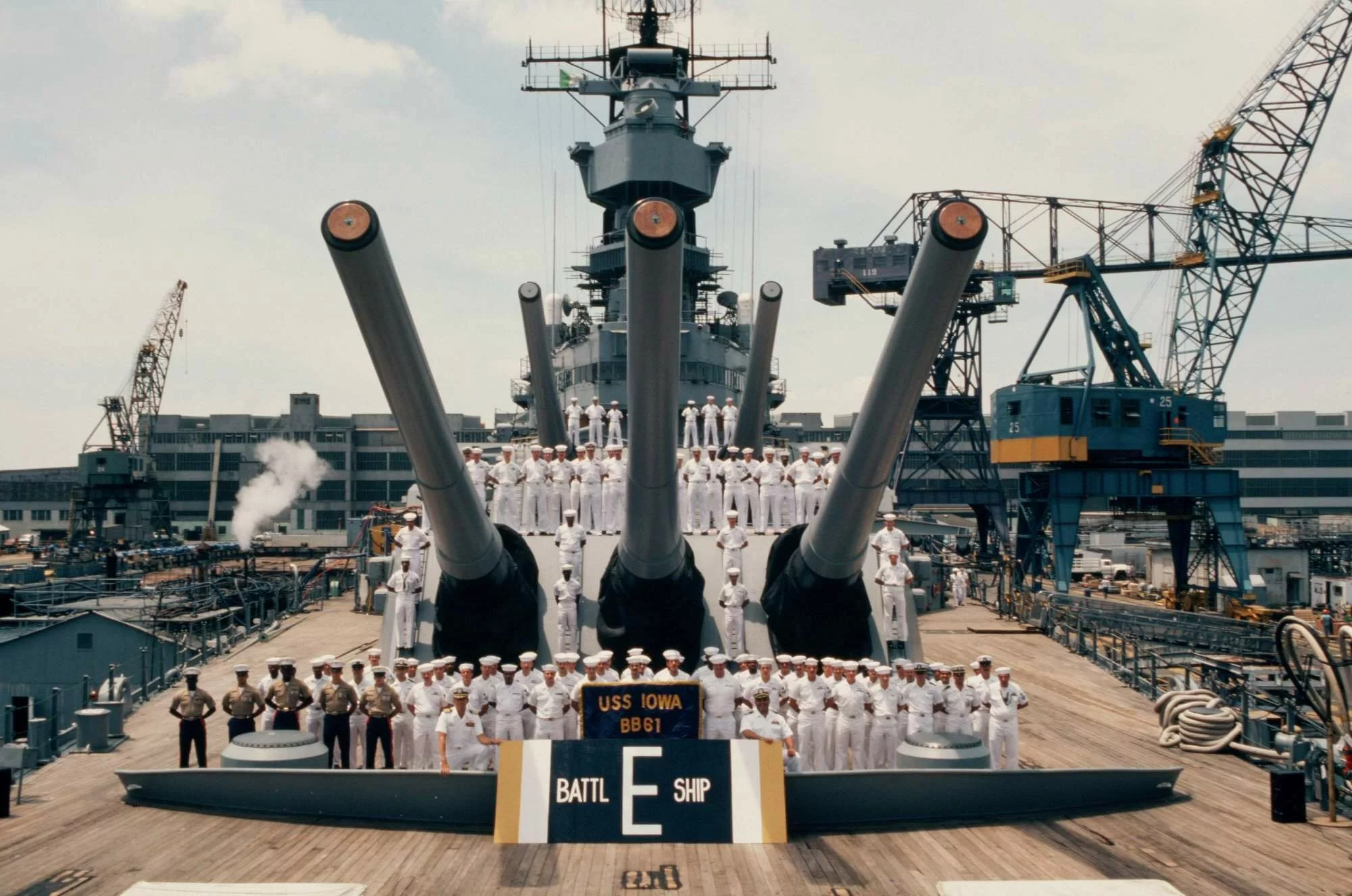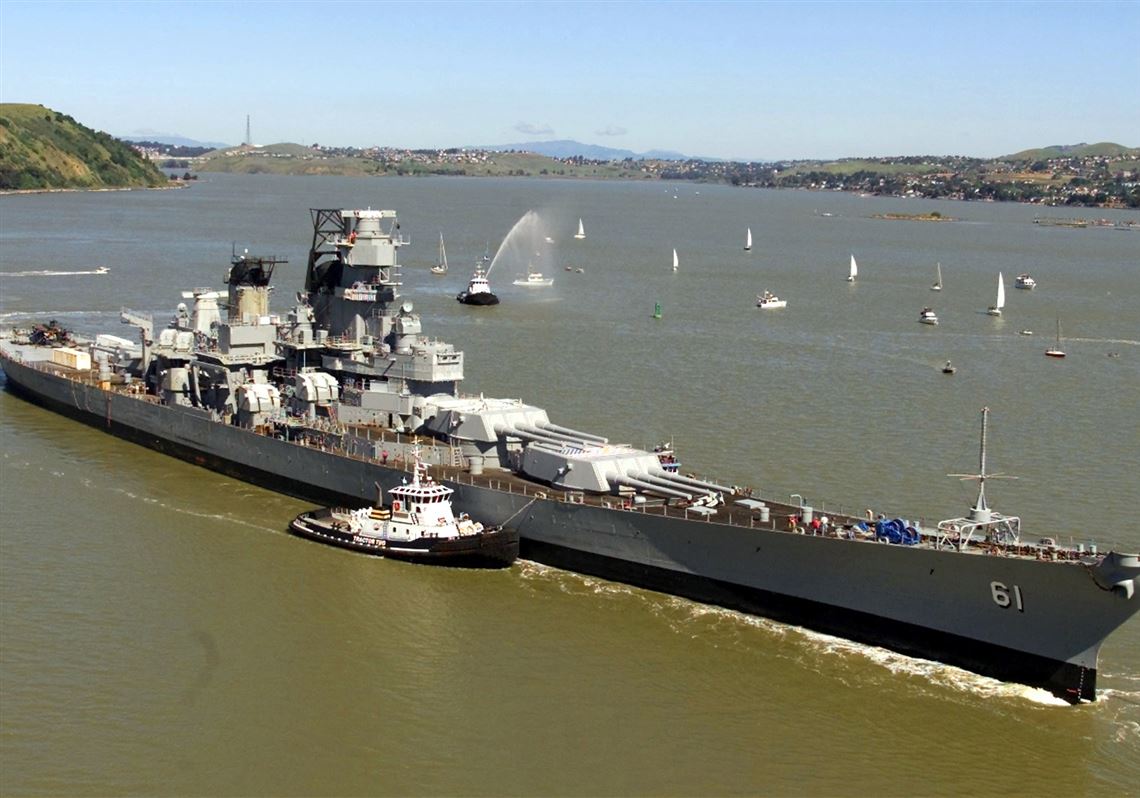Gulf War Battleship - USS Iowa fires a salvo of nine 16-inch guns on 15 August 1984 during a post-modern firepower demonstration.
On display at the Pacific Battleship Cter in the Port of Los Angeles (33°44′32″N 118°16′38″W / 33.7423°N 118.2772°W / 33.7423; -118.274″3Coordinate N 118°16′38″W / 33.7423°N 118.2772°W / 33.7423; -118.2772)
Gulf War Battleship
USS Iowa (BB-61), the flagship of her class and the fourth in the US Navy, is a decommissioned battleship named after the state of Iowa. Due to the retirement of the Montana-class battleships, Iowa is the last lead ship of any class of US warships, and the only ship of her class to serve in the Atlantic Ocean during World War II.
Raised Armored Box Launcher Aboard Battleship Wisconsin
During the Second World War, President Franklin D. Roosevelt transported across the Atlantic to Mers el Kebir, Algeria for a crucial conference in 1943 in Tehran with the Prime Minister of the United Kingdom Winston Churchill and Joseph Stalin, the leader of the Soviet Union. Union. Transferred to the Pacific Fleet in 1944, the Iowa bombarded the bridgeheads at Kwajalein and Iwetok prior to the Allied amphibious landings and cleared aircraft carriers operating in the Marshall Islands. He also served as commanding officer of the Third Fleet under Admiral William F. Halsey during the surrender of Japan in Tokyo Bay.
During the Korean War, the Iowa took part in raids on the coast of North Korea, after which it was withdrawn from the reserve fleets of the US Navy, known as the "canning fleet". It was revived in 1984 as part of the Navy's 600 ship plan and was deployed in the Atlantic and Pacific fleets to counter the dramatically expanded Soviet fleet. In April 1989, an explosion of unknown origin destroyed her No. 2 gun turret, killing 47 sailors.
Iowa was last decommissioned in October 1990 after 19 years of active service and was initially removed from the Naval Vessel Register (NVR) in 1995 before being reinstated from 1999 to 2006 under federal laws requiring for storage and maintenance. of two Iowa class battleships. In 2011, Iowa was donated to the non-profit organization Pacific Battleship Cter of Los Angeles and in 2012 she was permanently relocated to Pier 87 at the Port of Los Angeles, where she was displayed to the public as a museum of the USS Iowa .
USS Iowa was laid down at the New York Navy Yard in June 1940. She was launched on 27 August 1942 with the patronage of Elo Wallace (wife of Vice President Chris Wallace) and commissioned on 22 February 1943 with Captain John L .McCree in control.
America's Battleships Almost Became Part Aircraft Carriers
USS Iowa's main battery consisted of nine 16 in (406 mm)/50 caliber Mark 7 guns that could fire 2,700 pounds (1,200 kg) of armor piercing 20 nautical miles (23 mi; 37 km). Her auxiliary battery consisted of twenty 5-inch (127 mm)/38-caliber guns in twin mounts that could fire at targets up to 12 nautical miles (14 mi; 22 km). With the advent of aviation and the need to gain and maintain air superiority, it became necessary to protect the growing fleet of Allied aircraft carriers; Until today, the Iowa was equipped with a number of 20 mm Oerlikon and 40 mm Bofors anti-aircraft guns to protect the Allied aircraft carriers from enemy air strikes.
On February 24, 1943, the Iowa put to sea for a test cruise in the Chesapeake Bay and along the Atlantic coast. On 27 August, she sailed to Argtia, Newfoundland to counter the threat of the German battleship Tirpitz, which was reportedly operating in Norwegian waters, and then returned to the United States on 25 October for a two-week service at the Norfolk Naval Shipyard.
When Iowa was chosen to transport President Franklin D. Roosevelt to the Cairo and Tehran conferences, she was fitted with Roosevelt's meeting bath. Roosevelt, who was paralyzed in 1921, would not have been able to use the shower effectively.

In November 1943, President Roosevelt, Secretary of State Cordell Hull, Roosevelt's Chief of Staff Admiral William D. Leahy, Army General Staff Chief George C. Marshall, Chief of Naval Operations Ernest King, Commander of the United States Army in Iowa . Air Force Hri "Hap" Arnold, Harry Hopkins and other military leaders in Mers el Kebir, Algeria, on the first leg of their trip to the Tehran Conference.
Japanese Battleship Yamato
Among the ships that escorted Iowa on this cruise was the destroyer USS William D. Porter, which was involved in a number of accidents, the most serious of which involved a torpedo drill which caused William D. Porter's torpedo to come out of r tube and go away. to the side.Iowa. .
After being warned, Iowa turned sharply to avoid being hit by a torpedo, and the torpedo exploded in the wake of the ship. Iowa was unscathed and turned her main guns on William D. Porter, fearing that the smaller ship might be involved in some sort of assassination plot.
Roosevelt addressed the crew of the Iowa before departure, saying: "...from all I have seen and heard, the Iowa is a 'happy ship' and I know that I have been in the Navy for many years - and you know what he means." He also referred to the progress made at the conference before concluding his speech with "... good luck and remember that I am with you in spirit, with all of you."
As the flagship of the 7th Battleship Division (BatDiv 7), the Iowa left the United States on 2 January 1944 for the Pacific, crossing the Panama Canal on 7 January before her first combat campaign in the Marshall Islands campaign. Between 29 January and 3 February, it supported carrier strikes launched by Rear Admiral Frederick C. Sherman's Task Force 58.3 (TG 58.3).
Jdr Military Service
Against Kwajalein and Ivetok atolls. Her next assignment was to support air strikes against Japan's main naval and logistics base at Truk, Caroline Islands. The Iowa, along with other ships, was detached from the support group on February 16, 1944, to conduct an anti-shipping raid around Truk in order to destroy enemy warships moving north. During this operation, the Iowa, along with her sister New Jersey, sank the Japanese light cruiser Katori, the cruiser that had escaped from Truk the day before after Operation Hailstone, a US air attack on Truk.
On 21 February, she was underway with Task Force Fast Carrier (alternatively designated TF 38 with 3rd Fleet and TF 58 with 5th Fleet), making initial strikes against Saipan, Tinian, Rota and Guam in the Marianas. On March 18, 1944, the Iowa, under the flag of Vice Admiral Willis A. Lee (Commander of the Battleships of the Pacific), joined the bombardment of Mili Atoll in the Marshall Islands. Despite being hit by two Japanese 4.7-inch (120 mm) shells, Iowa sustained minor damage. It joined TF 58 on 30 March and supported air strikes against the Palau and Carolines for several days.
Between 22 and 28 April, Iowa supported air raids on Holland (now known as Jayapura), Aitape, and the Wake Islands in support of army forces on Aitape and at Tanahmera Field and Humboldt in New Guinea. He joined the task force's second strike on Truk on 29 and 30 April and bombarded Japanese installations on Ponapa in the Carolinas on 1 May.

During the early stages of the Marianas and Palau campaign, the Iowa protected American aircraft carriers during air attacks on Saipan, Tinian, Guam, Rota, and Pagan Island on 12 June. Iowa was sent to bombard enemy installations on Saipan and Tinian on June 13-14, destroying a Japanese ammunition depot. On 19 June, during the battle known as the Battle of the Philippine Sea, Iowa, as part of the battle line of TF 58, helped repel four massive air raids by the Japanese Middle Fleet. This resulted in the near destruction of the Japanese carrier air force, with Iowa claiming three enemy aircraft destroyed. Iowa joined in pursuit of the fleeing enemy fleet, shooting down one torpedo bomber and helping to destroy another.
Uss Alabama Battleship Memorial Park (mobile)
Through July, Iowa remained off the Marianas, supporting air strikes against the Palaus and landings on Guam. After a month's rest, Iowa sailed from Yvetoq with the Third Fleet and helped support the Peleliu landings on 17 September. She protected aircraft carriers during air strikes against the Central Philippines to neutralize enemy aircraft for the long-awaited attack on the Philippines. On October 10, Iowa arrived at Okinawa for a series of air strikes against the Ryukyu Islands and Formosa. She supported the air strikes against Luzon on 18 October and continued her duties during General Douglas MacArthur's landing on Leyte on 20 October.
In a last-ditch effort to stop the US campaign to retake the Philippines, the Imperial Japanese Navy retaliated with Sho-Go 1, a three-pronged attack aimed at destroying the US landing forces in Leyte Gulf. The plan called for Vice Admiral Jisaburo Ozawa to use the surviving Japanese carriers as bait to divert the American carriers TF 38 away from the Philippine beachheads, allowing Imperial Japanese Admirals Takeo Kurita, Kiyohide Shima, and Shoji Nishimura led surface task forces through the San. Bernardino Strait and Surigao, where they were to meet and
Longest song ever recorded, longest recorded marriage, longest sniper shot recorded, longest recorded tapeworm, longest sniper shot ever recorded, longest putt ever recorded, longest fingernails ever recorded, longest recorded shot, longest recorded, longest drift ever recorded, longest recorded earthquake, longest recorded song

0 Comments